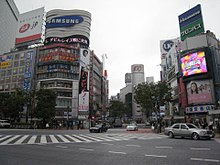| Shibuya-kei | |
|---|---|
 Shibuya Crossing, 2007 | |
| Native name | 渋谷系 |
| Stylistic origins | |
| Cultural origins | 1990s, Shibuya, Tokyo, Japan |
| Fusion genres | |
| Akishibu-kei | |
| Other topics | |
Shibuya-kei (Japanese: 渋谷系, lit. "Shibuya style") is a microgenre[7] of pop music[1] or a general aesthetic[8] that flourished in Japan in the mid-to-late 1990s.[3] The music genre is distinguished by a "cut-and-paste" approach that was inspired by the kitsch, fusion, and artifice from certain music styles of the past.[9] The most common reference points were 1960s culture and Western pop music,[1] especially the work of Burt Bacharach, Brian Wilson, Phil Spector, and Serge Gainsbourg.[10]
Shibuya-kei first emerged as retail music from the Shibuya district of Tokyo.[5] Flipper's Guitar, a duo led by Kenji Ozawa and Keigo Oyamada (Cornelius), formed the bedrock of the genre and influenced all of its groups, but the most prominent Shibuya-kei band was Pizzicato Five, who fused mainstream J-pop with a mix of jazz, soul, and lounge influences. Shibuya-kei peaked in the late 1990s and declined after its principal players began moving into other music styles.
Overseas, fans of Shibuya-kei were typically indie pop enthusiasts, which contrasted with the tendency for other Japanese music scenes to attract listeners of foreign anime fandoms. This was partly because many Shibuya-kei records had been distributed in the United States through major indie labels like Matador and Grand Royal.[3]
- ^ a b c d e Anon. (n.d.). "Shibuya-Kei". AllMusic.
- ^ a b c d e Reynolds 2011, p. 168.
- ^ a b c d e Ohanesian, Liz (April 13, 2011). "Japanese Indie Pop: The Beginner's Guide to Shibuya-Kei". LA Weekly.
- ^ 第14回 ─ シティー・ポップ [No. 14 ─ City Pop] (in Japanese). bounce.com. 2003-05-29. Archived from the original on 2007-08-24. Retrieved 2008-11-17.
- ^ a b c d e Cite error: The named reference
Joffe2016was invoked but never defined (see the help page). - ^ a b c Cite error: The named reference
Martin2013sunwas invoked but never defined (see the help page). - ^ "Singles Club: The revolution will not be televised, it'll be robotized". Factmag. August 28, 2018. Retrieved September 27, 2018.
- ^ McKnight 2009, p. 451.
- ^ Tonelli 2004, p. 4.
- ^ Lindsay, Cam (4 August 2016). "Return to the Planet of Cornelius". Vice. Retrieved 17 April 2020.